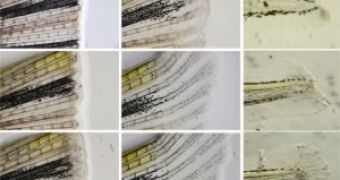Many lizards, newts and frogs can regrow very complex body parts.
But scientists have now focused on the ability of the zebrafish to put back lost chunks of its tail fin, in just a week. A tail fin is an organ of complicated structure, with many different types of cells and tissues.
Scientists have argued that, just as warm-blooded mammals evolved from cold-blooded creatures, it is possible that they still possess regenerative powers hidden in their genes.
Humans (and mammals) are constantly renewing blood components, skeletal muscles and skin and are able to regenerate liver tissue and repair minor injuries to bone, muscle, the tips of our toes and fingers, and the corneas of our eyes.
Recovering this ability of amphibians and fish to re-grow complex parts might create treatments for people whose hearts, spinal cords, eyes or arms and legs have been badly injured. The investigation has uncovered some of the genes and cell-to-cell communication pathways that enable zebrafish to regrow their tail fins. "The ability to regenerate body parts such as those that are damaged by injury or disease," said Dr. Randall Moon, professor of pharmacology at the University of Washington (UW) "involves creating cells that can take any number of new roles. This can be done by re-programming cells that already have a given function or by activating resident stem cells."
A particular cell-to-cell communication, the Wnt/Beta-catenin signaling, tunes the fate of these undeveloped cells as an embryo forms. The signals indicate to the waiting cells which spot to help form the embryo, what kinds of cells to become there, and how many cells like themselves should be reproduced. These signals also tell stem cells in adult organisms what functions to undertake.
Once tissue formation starts, something has to stop it before growth gets out of hand. This study points that Wnt/Beta signaling also provokes the regeneration of tail fins in zebrafish. A distinct signaling pathway activated by a different kind of Wnt protein (Wnt5b), turns off the genes turned on by Wnt/Beta-catenin, impairs cell proliferation, and inhibits fin regeneration.
Fish with an inactive mutant of Wnt5b protein regenerate missing Tails very quickly. Too much of other related protein, Wnt8, also promotes cell proliferation in the regenerating fin. "We can actually increase the rate of regeneration by turning on these genes," Moon said. "Wnt/Beta-catenin signaling is activated in the regenerating zebrafish tail and is required for the formation and subsequent proliferation of the progenitor cells of the blastema." (a little nub of cells that directs regeneration)
"It is most likely the inability of humans to form a blastema in the first place that renders us unable to re-grow arms and legs," said Cristi Stoick-Cooper, a graduate student in the multidisciplinary Neurobiology and Behavior program at the UW. "Our study is the first to identify a gene (Wnt5b) that inhibits regeneration," said Gilbert Weidinger, a former UW postdoctoral fellow.
"This is very exciting, because this gene might also inhibit regeneration in mammals and man. So, if we find ways of interfering with the function of Wnt5b, we might be able to promote regeneration."
"Because the same genes for turning on and turning off growth and development are found in humans, and drugs exist that can regulate this pathway, the findings are directly relevant to future testing of whether scientists can increase the capacity of humans to re-build damaged organs." added Moon.

 14 DAY TRIAL //
14 DAY TRIAL //